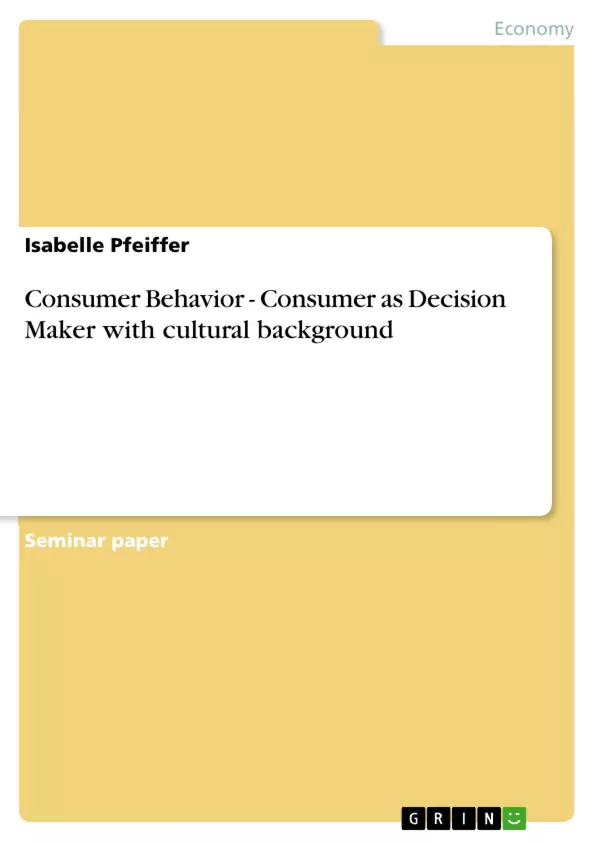Introduction
1.1 In general to the “Hauptseminar” paper consumer behavior – consumer as decision maker with cultural background
The target of this “Hauptseminar” paper is, to show the decision making process of consumers with different cultural background and also the influences on the choice of the product or service. Consumers have to make decisions all the time. Sometimes decisions are made on habits, and sometimes consumers first have to collect information before deciding, because the purchase is a deal with risk. One of the main objectives of this paper are to understand how consumers process information into decisions and the strategic implication of this process, and to gain an insight into the continuum of factors that affect consumer decisions. In the case “‘But where are the French?’ – The trials and tribulations of Euro Disneyland” I have chosen the difference between Americans and Europeans in the decision making process is described.
Textual this “Hauptseminar” paper is structured as the following:
After advancing to the topic, the terms “consumer behavior”, “decision maker”, and “culture” are defined within the introduction. The main part is divided into three blocks, the case, the dimensions of consumer behavior, and the influences on consumer behavior. In the first main part the case of Eurodisney is described and analyzed. The difference between Europeans and Americans in spending money in theme parks, the difference in their tastes and the different vacation situation is shown in this case. In the second main part the dimensions of consumer behavior are explained and discussed on the basis of the case. The three dimensions who buys, how consumers buy (the decision making process) and the choice criteria are discussed in more detail. The decision making process is subdivided into five steps: the problem recognition, the information search, the evaluation of alternatives, the product choice, and the outcomes like costumer satisfaction. The influences on consumer behavior are forming the third main part of this “Hauptseminar” paper, which is subdivided into the buying situation, personal influences, such like lifestyle, stage in the life cycle, or beliefs and attitudes, and the social influences, such like family, culture, and geodemographics. The summary forms the closing of the text of this hauptseminarpaper, followed by the appendices, and the bibliography.
[...]
Inhaltsverzeichnis (Table of Contents)
- 1 Introduction
- 1.1 In general to the "Hauptseminar" paper consumer behavior - consumer as decision maker with cultural background
- 1.2 Definitions
- 1.2.1 Consumer behavior
- 1.2.2 Decision maker
- 1.2.3 Culture
- 2 The case
- 3 The dimensions of consumer behavior
- 3.1 Understanding the consumer behavior
- 3.1.1 Who buys?
- 3.1.2 How consumers buy? – The decision making process
- 3.1.2.1 Problem recognition
- 3.1.2.2 Information search
- 3.1.2.3 Evaluation of alternatives
- 3.1.2.4 Product choice
- 3.1.2.5 Outcomes
- 3.1.3 Choice criteria
- 4 Influences on consumer behavior
- 4.1 The buying situation
- 4.1.1 Extended problem solving
- 4.1.2 Limited problem solving
- 4.1.3 Habitual problem solving
- 4.2 Personal influences
- 4.2.1 Personal factors
- 4.2.2 Psychological factors
- 4.3 Social influences
- 4.3.1 Cultural factors
- 4.3.2 Social factors
- 5 Summary
Zielsetzung und Themenschwerpunkte (Objectives and Key Themes)
This "Hauptseminar" paper examines the decision-making processes of consumers from different cultural backgrounds and the influences on their product or service choices. The objective is to understand how consumers transform information into decisions and the strategic implications of this process, along with the factors influencing these decisions. The paper specifically focuses on the case of Euro Disneyland to demonstrate the difference in decision-making between Americans and Europeans.
- Consumer behavior and decision-making
- Cultural influences on consumer choices
- The decision-making process
- Factors influencing consumer behavior
- Cultural differences in consumer behavior, as illustrated in the Euro Disneyland case
Zusammenfassung der Kapitel (Chapter Summaries)
- Chapter 1: Introduction
- Chapter 2: The case
- Chapter 3: The Dimensions of Consumer Behavior
- Chapter 4: Influences on Consumer Behavior
This chapter introduces the topic of consumer behavior, focusing on decision-making processes influenced by cultural background. It defines key terms like "consumer behavior," "decision maker," and "culture," setting the stage for the paper's exploration of these concepts.
This chapter delves into the Euro Disneyland case, analyzing the differences in spending habits, tastes, and vacation preferences between Americans and Europeans. It provides a concrete example of how cultural factors impact consumer decisions.
This chapter explores the dimensions of consumer behavior, focusing on "who buys," "how consumers buy" (the decision-making process), and "choice criteria." The decision-making process is further broken down into five steps: problem recognition, information search, evaluation of alternatives, product choice, and outcomes such as customer satisfaction.
This chapter delves into the various influences on consumer behavior, categorized as buying situation, personal influences, and social influences. Personal influences include factors like lifestyle, life stage, and beliefs/attitudes, while social influences encompass factors like family, culture, and geodemographics.
Schlüsselwörter (Keywords)
The paper focuses on the key terms and concepts of consumer behavior, decision-making, cultural influences, and the decision-making process. It uses the Euro Disneyland case as an example to demonstrate the impact of culture on consumer choices. The study also analyzes factors influencing consumer behavior, such as personal factors, psychological factors, and social influences, highlighting the role of culture and geodemographics in this context.
- Quote paper
- Isabelle Pfeiffer (Author), 2000, Consumer Behavior - Consumer as Decision Maker with cultural background, Munich, GRIN Verlag, https://www.grin.com/document/2473



